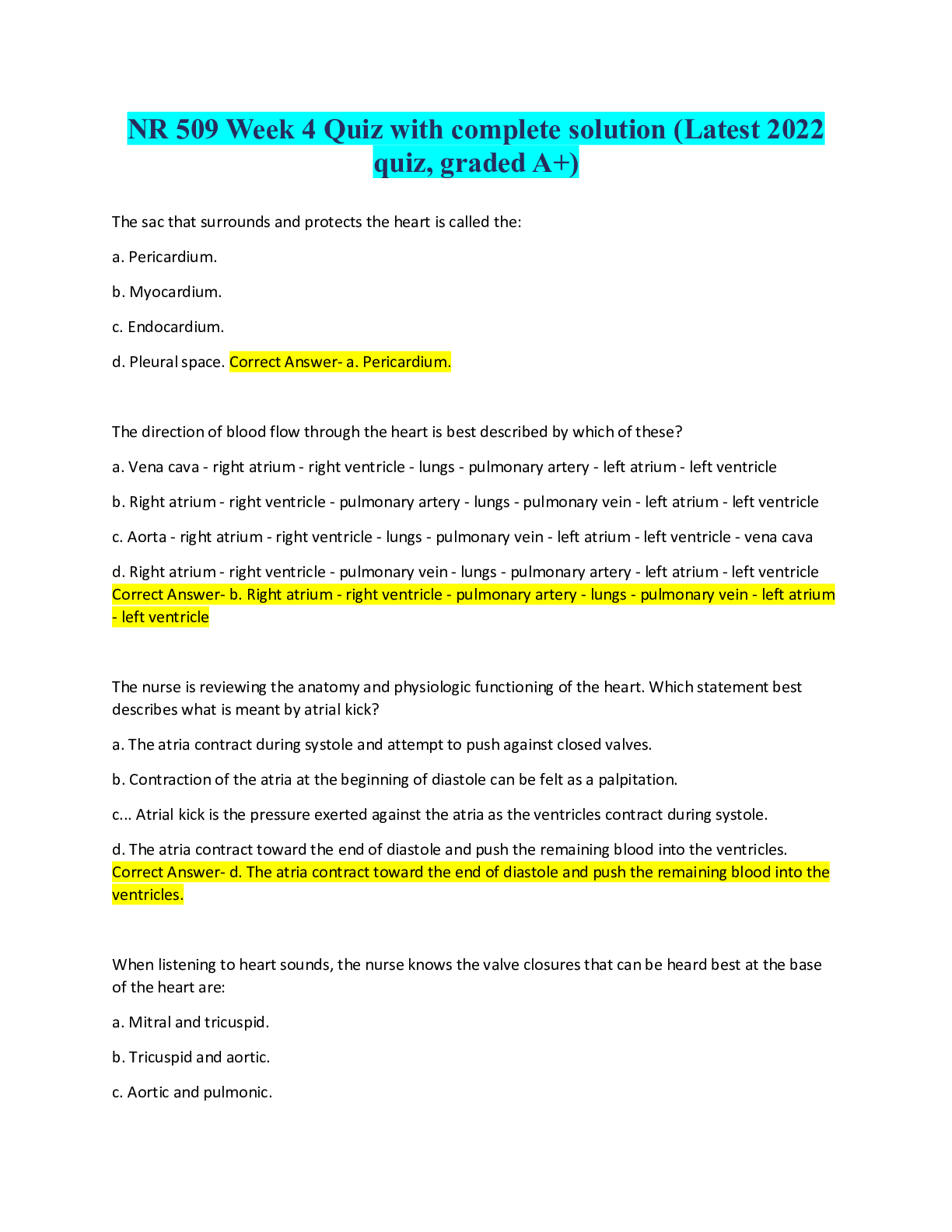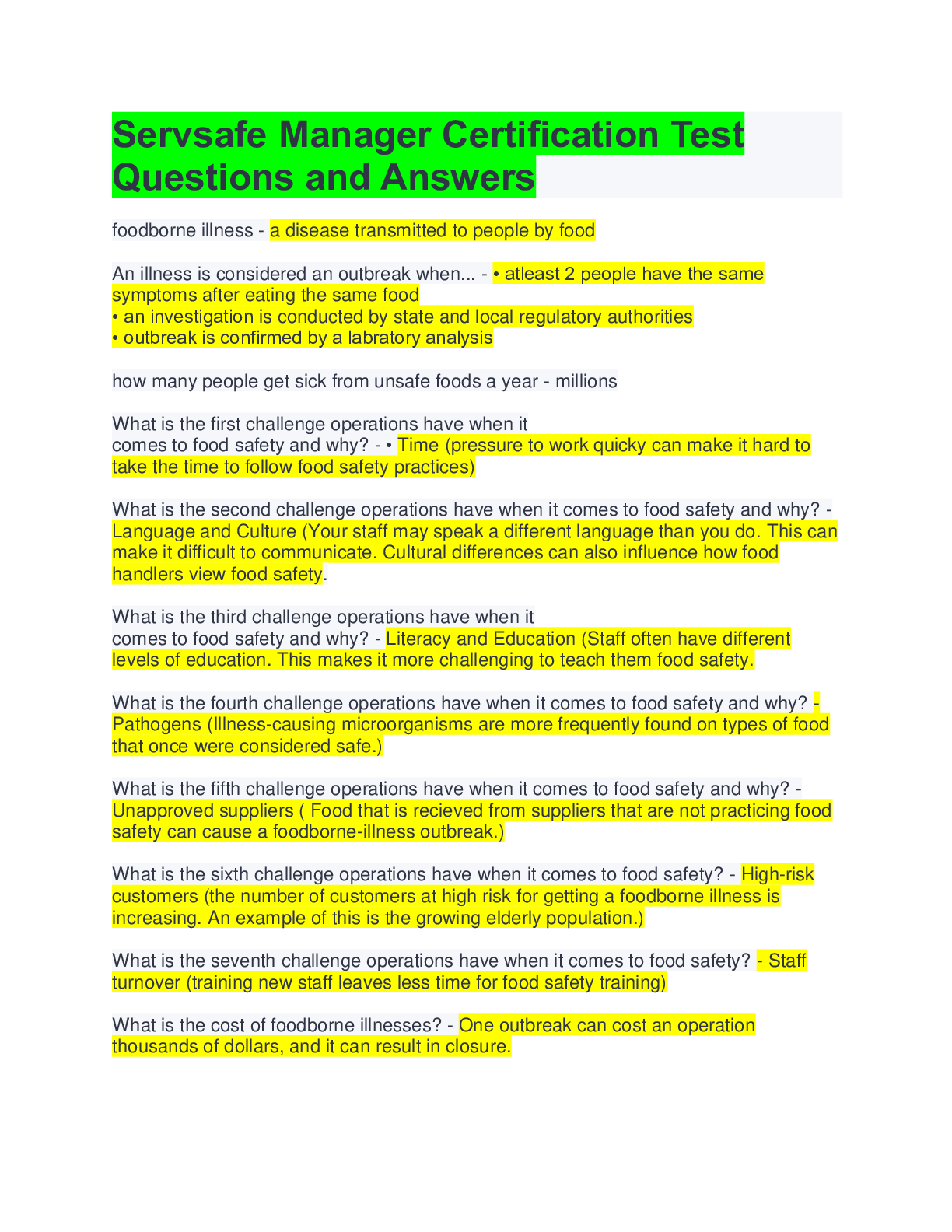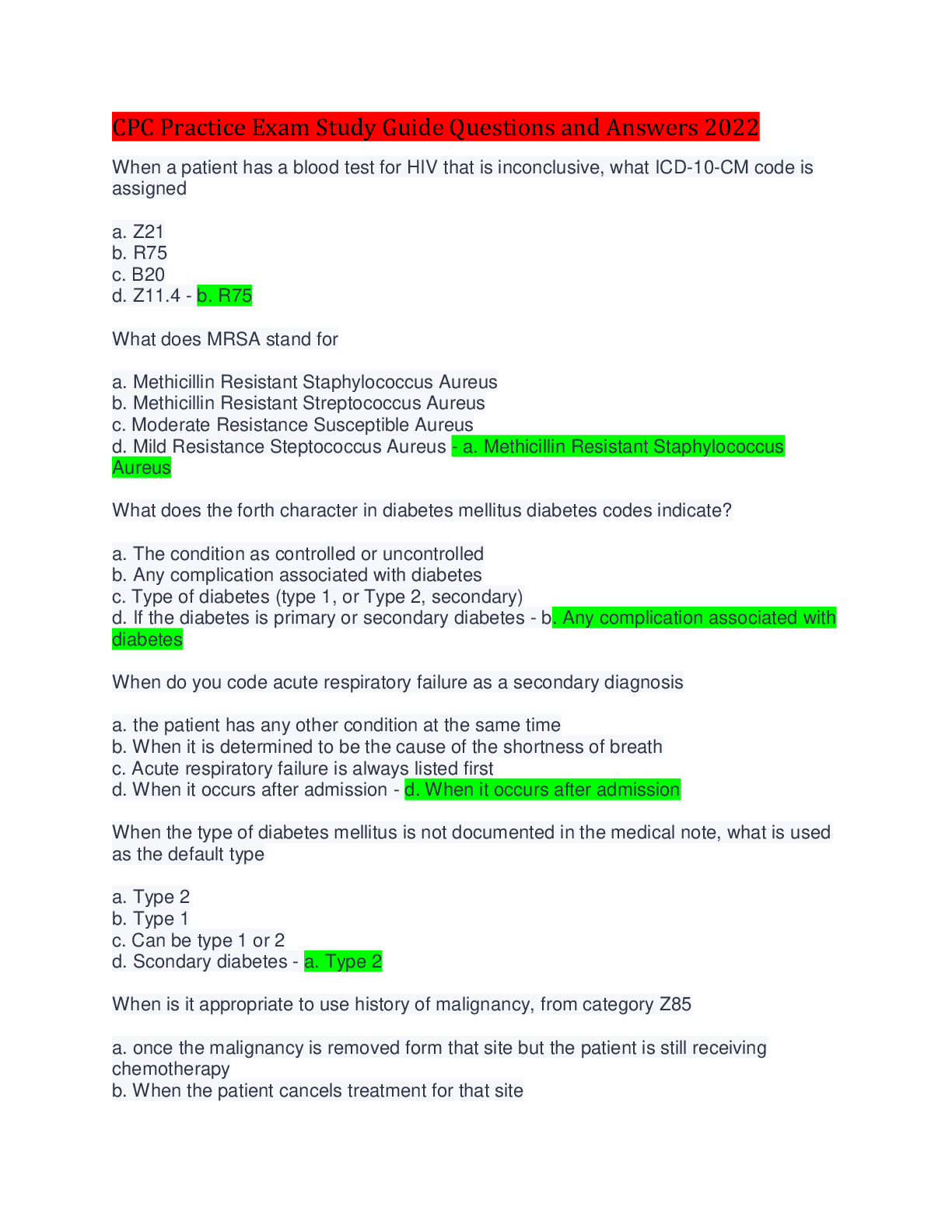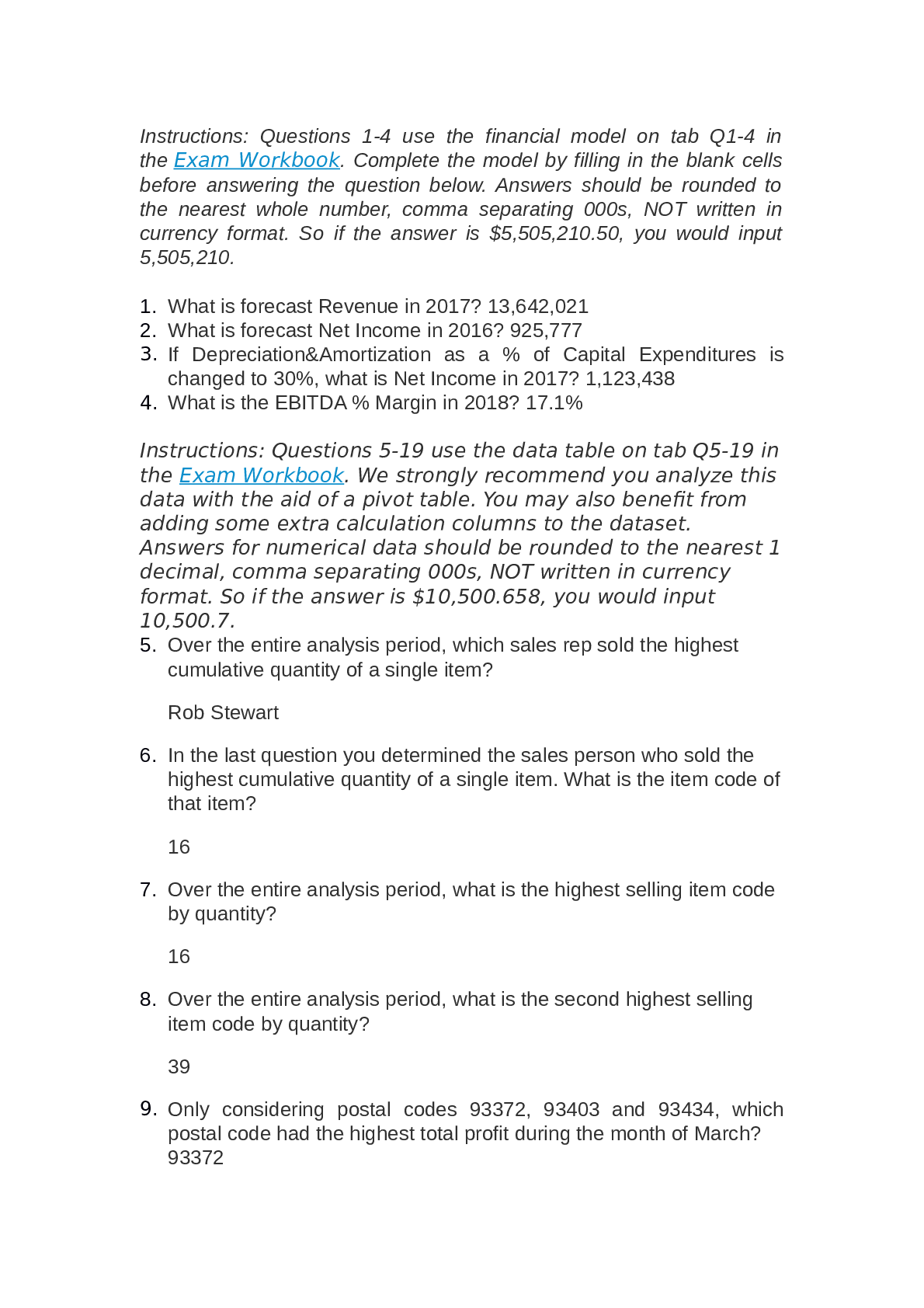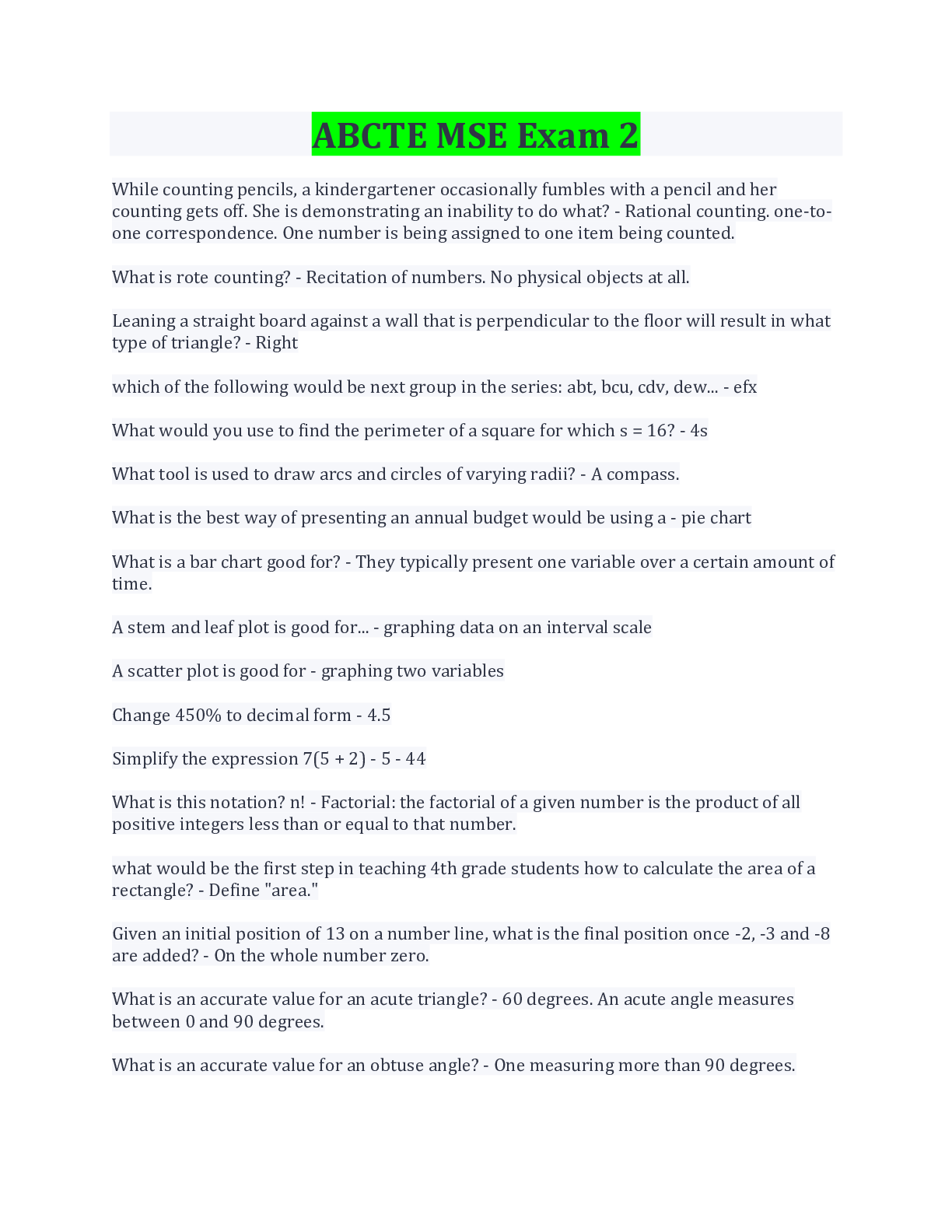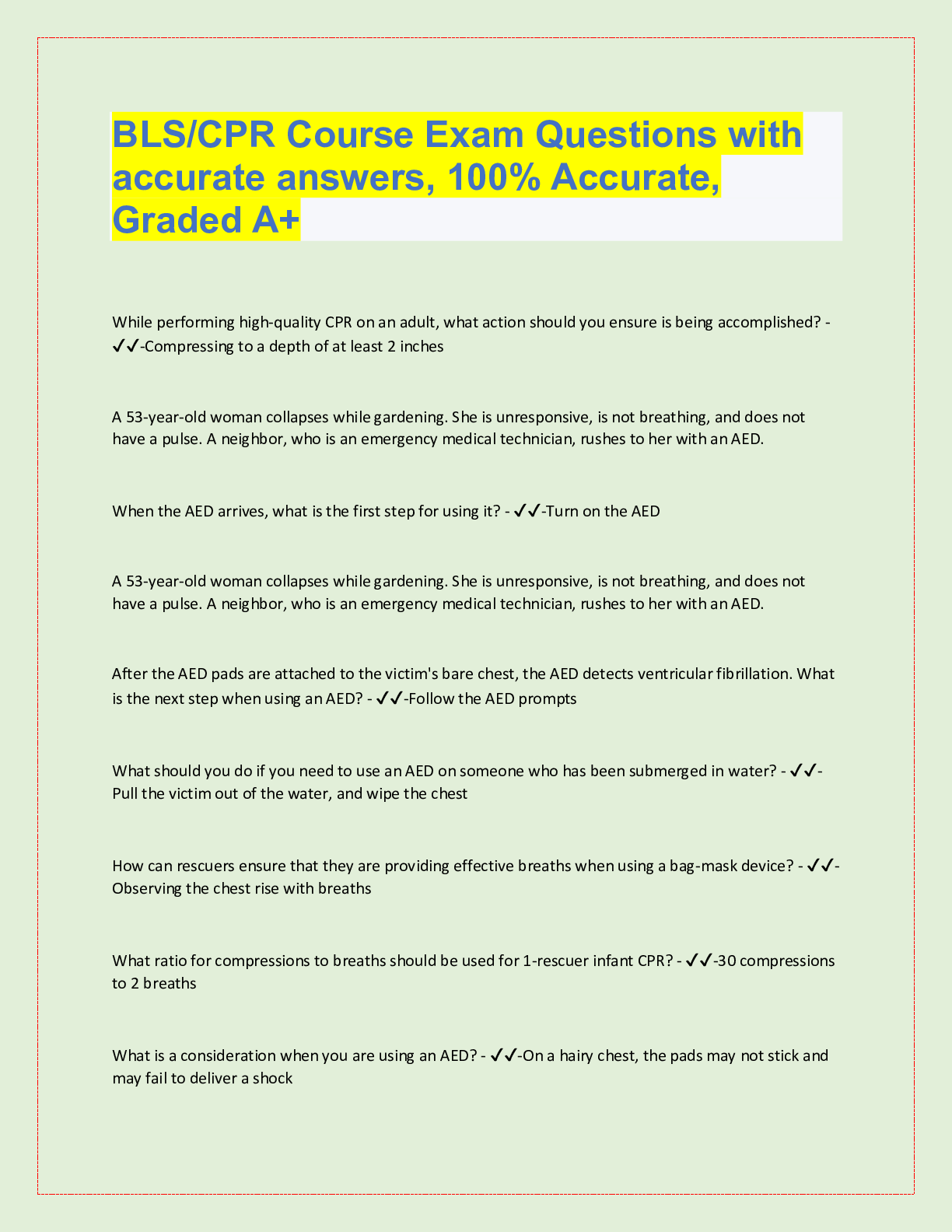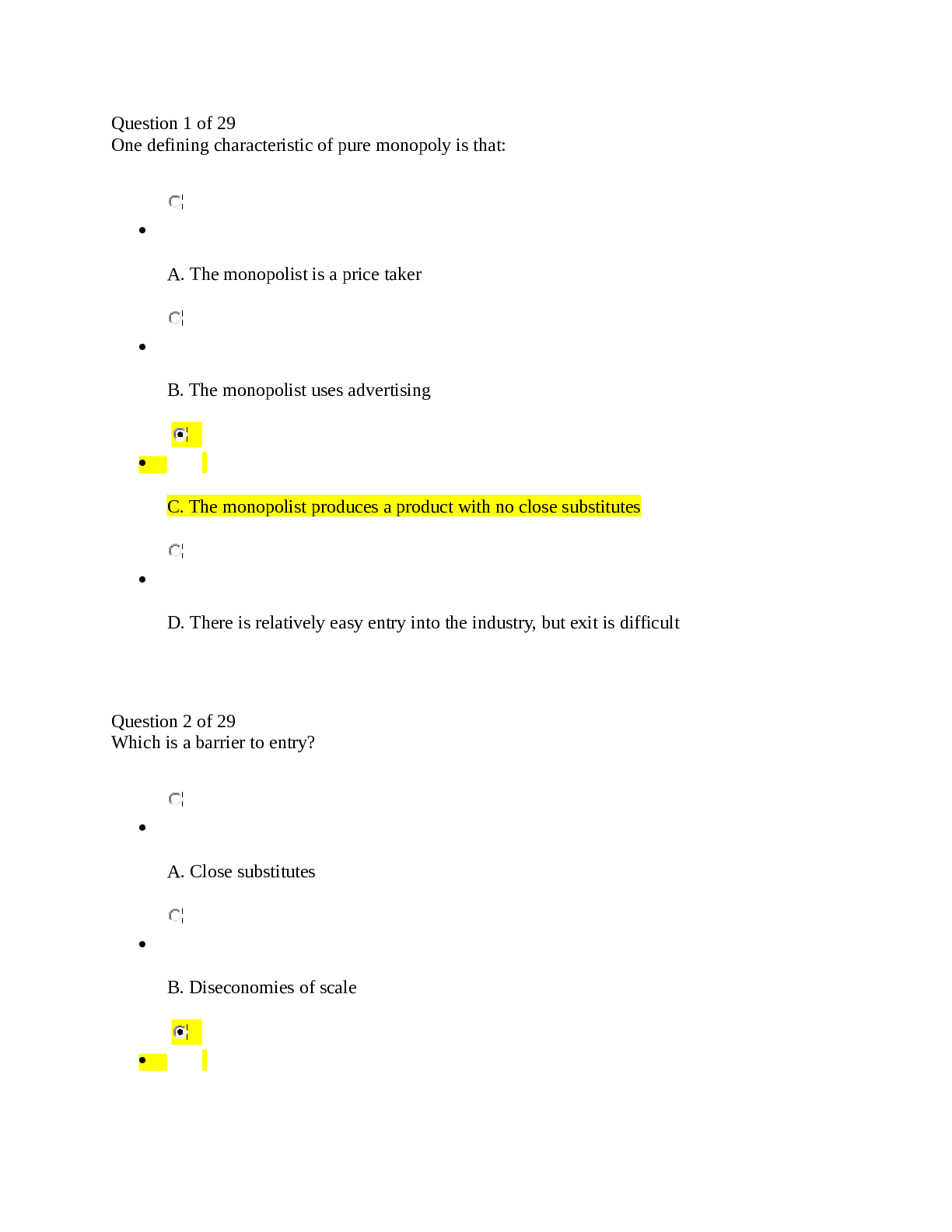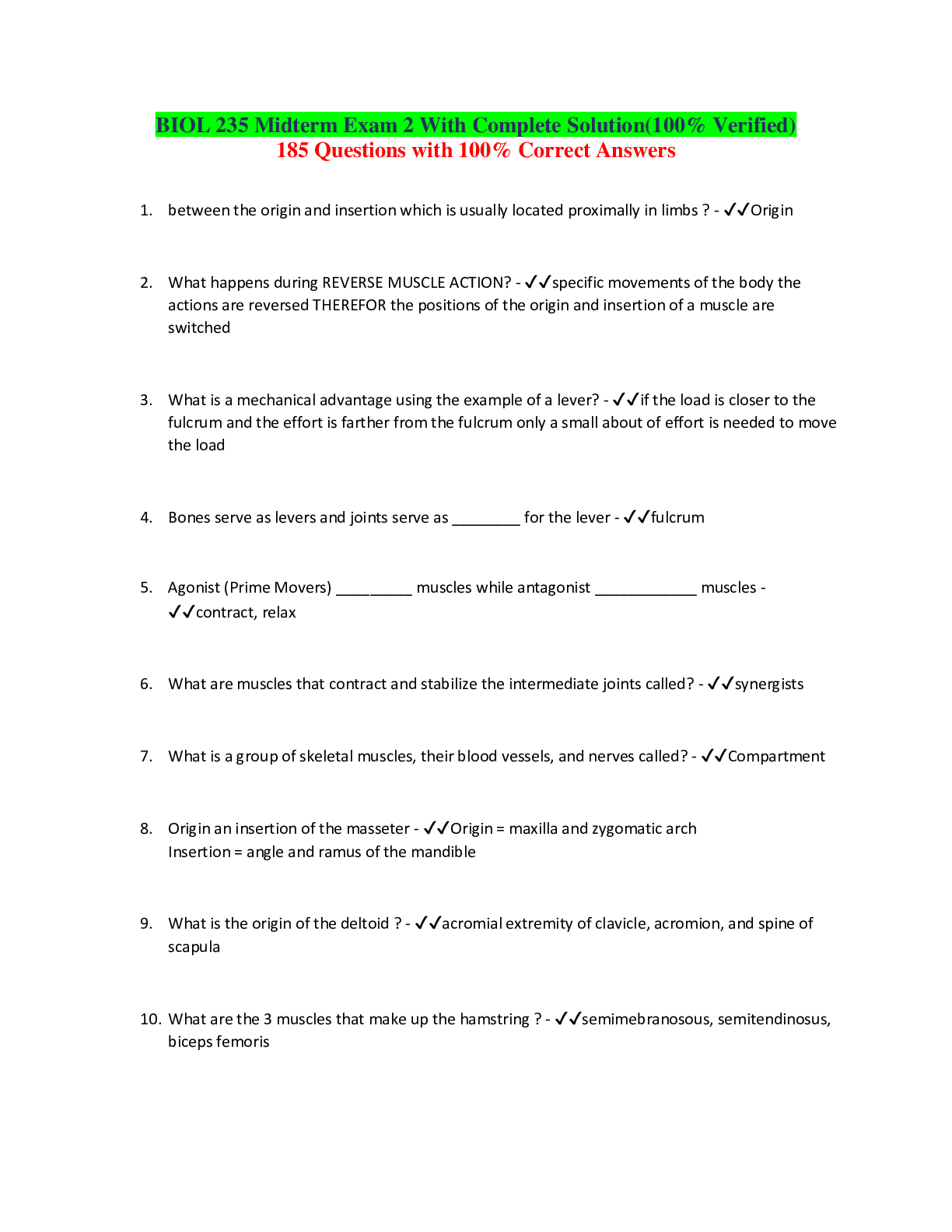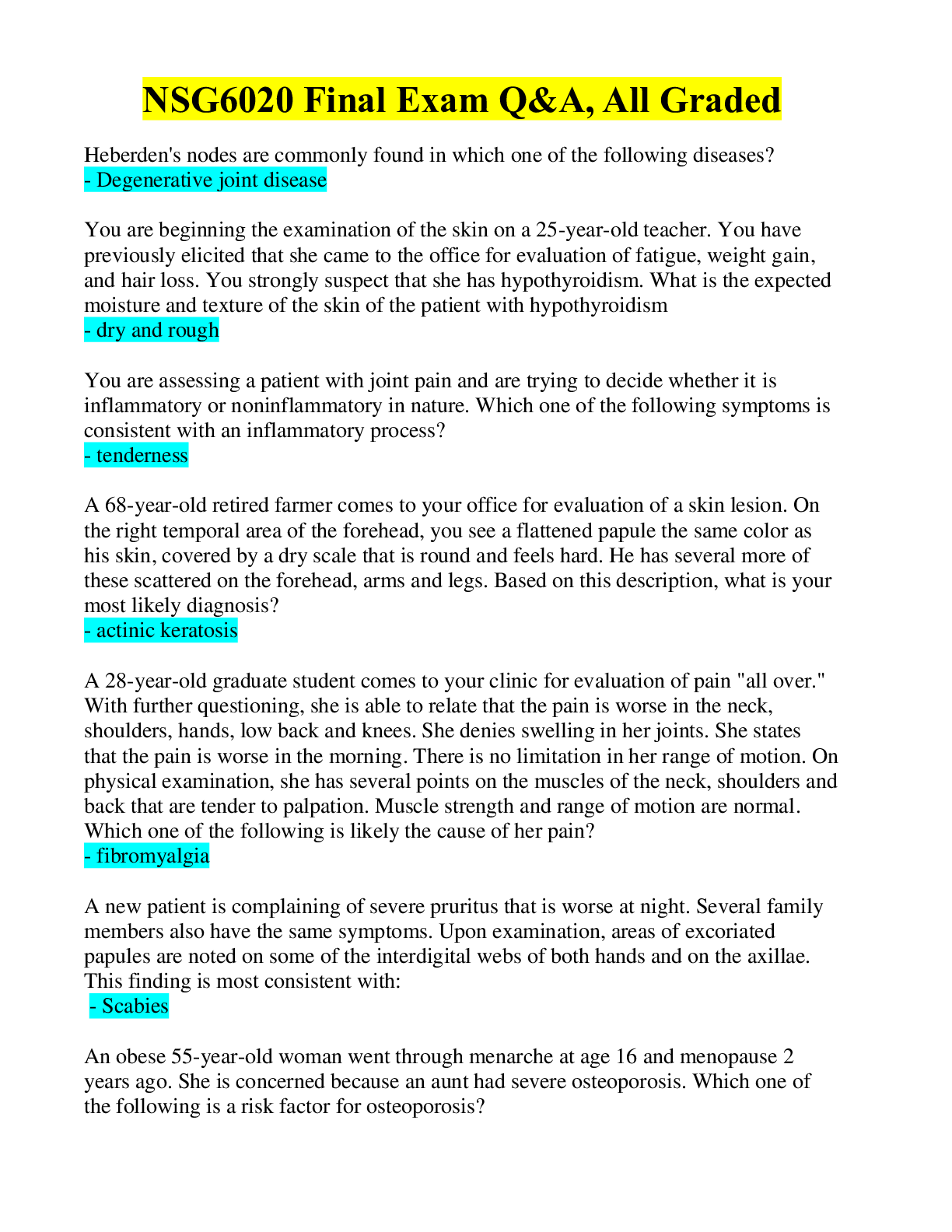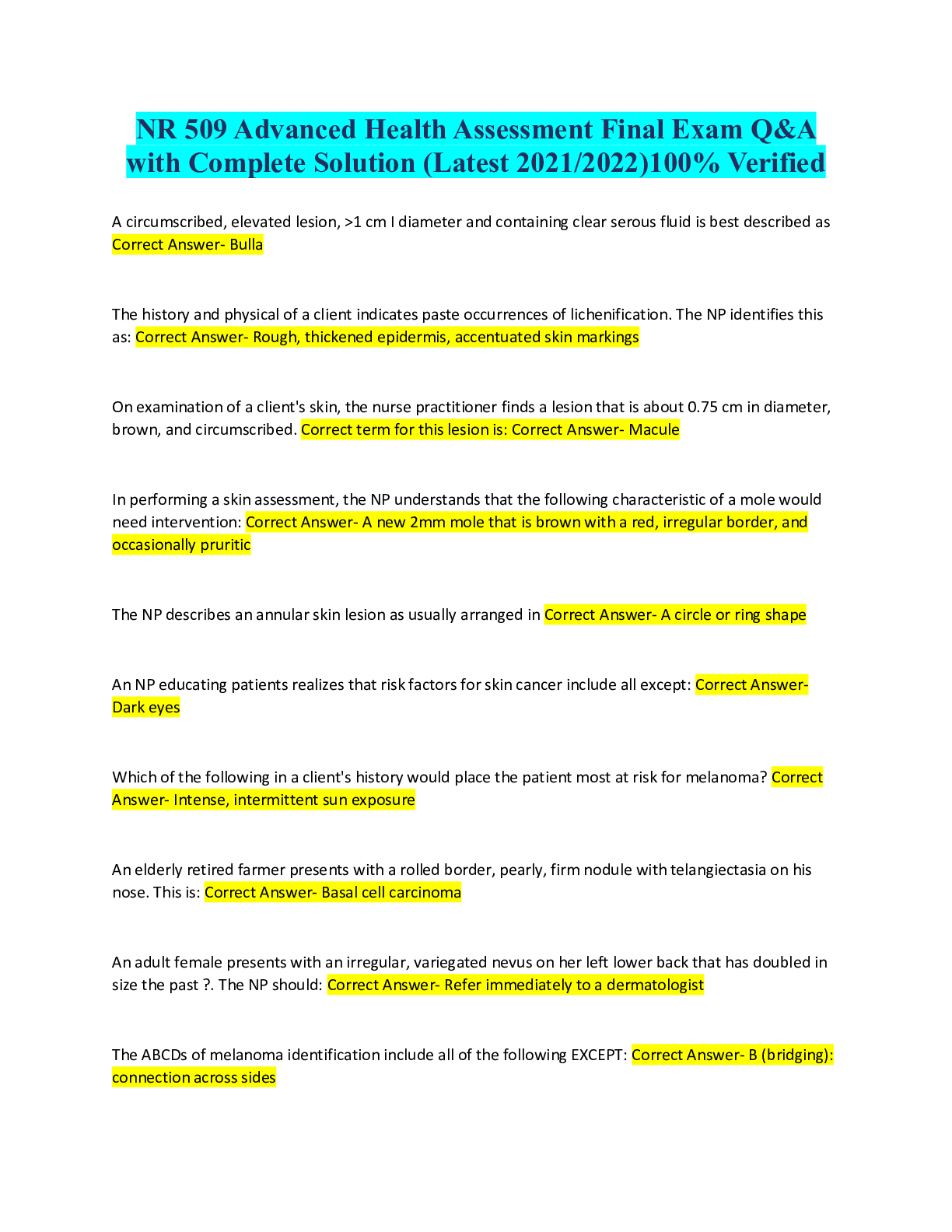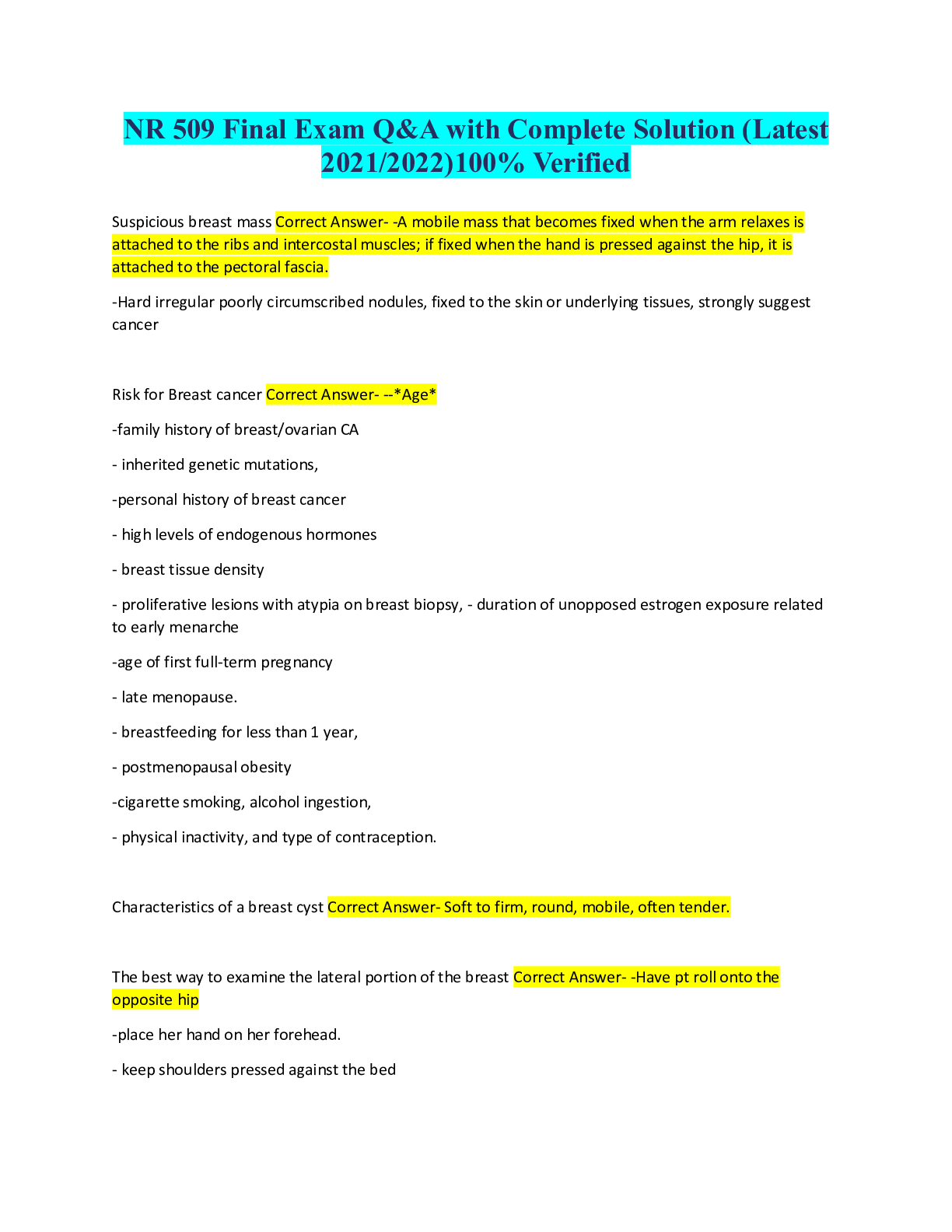*NURSING > QUESTIONS & ANSWERS > NR 509 Final Exam Q&A With Complete Solution(100% VERIFIED) (All)
NR 509 Final Exam Q&A With Complete Solution(100% VERIFIED)
Document Content and Description Below
NR 509 Final Exam Q&A With Complete Solution(100% VERIFIED) Appendicitis Correct Answer- 1. McBurney point tenderness 2. Rovsing sign 3. the psoas sign 4. the obturator sign --Appendicitis is tw... ice as likely in the presence of RLQ tenderness, Rovsing sign, and the psoas sign --The pain of appendicitis classically begins near the umbilicus, then migrates to the RLQ. Older adults are less likely to report this pattern. --Localized tenderness anywhere in the RLQ, even in the right flank, suggests appendicitis. McBurney Point Correct Answer- 1. McBurney point lies 2 inches from the anterior superior spinous process of ilium on a line drawn from that process to the umbilicus 2. Appendicitis is three times more likely if there is McBurney point tenderness. Rovsing sign Correct Answer- Press deeply and evenly in the LLQ. Then quickly withdraw your fingers. Pain in the RLQ during left-sided pressure is a positive Rovsing sign. Psoas Sign Correct Answer- --Place your hand just above the patient's right knee and ask the patient to raise that thigh against your hand. Alternatively, ask the patient to turn onto the left side. Then extend the patient's right leg at the hip. Flexion of the leg at the hip makes the psoas muscle contract; extension stretches it. --Increased abdominal pain on either maneuver is a positive psoas sign, sug-gesting irritation of the psoas muscle by an inflamed appendix. Obturator Sign Correct Answer- --Less helpful --Flex the patient's right thigh at the hip, with the knee bent, and rotate the leg internally at the hip. This maneuver stretches the internal obturator muscle. --Right hypogastric pain is a positive obturator sign, from irritation of the obturator muscle by an inflamed appendix. This sign has very low sensitivity.Acute Cholecystits Correct Answer- RUQ pain Murphy Sign Murphy Sign Correct Answer- Hook your left thumb or the fingers of your right hand under the costal margin at the point where the lateral border of the rectus muscle intersects with the costal margin. Alternatively, palpate the RUQ with the fingers of your right hand near the costal margin. If the liver is enlarged, hook your thumb or fingers under the liver edge at a comparable point. Ask the patient to take a deep breath, which forces the liver and gallbladder down toward the examining fingers. Watch the patient's breathing and note the degree of tenderness. --A sharp increase in tenderness with inspiratory effort is a positive Murphy sign. When positive, Murphy sign triples the likelihood of acute cholecystitis. Acute Pancreatitis Process Correct Answer- Intrapancreatic trypsinogen activation to trypsin and other enzymes, result-ing in autodigestion and inflammation of the pancreas Acute Pancreatitis Location Correct Answer- Epigastric, may radiate straight to the back or other areas of the abdomen; 20% with severe sequelae of organ failure Acute Pancreatitis Quality Correct Answer- Usually steady Acute PancreatitisTiming Correct Answer- Acute onset, persistent pain Acute Pancreatitis Aggrevating Factors Correct Answer- Lying supine; dyspnea if pleural effusions from capillary leak syn-drome; selected medications, high triglycerides may exacerbate Acute Pancreatitis Relieving factors Correct Answer- Leaning forward with trunk flexed Acute Pancreatitis Associated Symptoms and Setting Correct Answer- Nausea, vomiting, abdominal distention, fever; often recurrent; 80% with history of alcohol abuse or gallstones Peptic Ulcer Disease Process Correct Answer- Mucosal ulcer in stomach or duode-num >5 mm, covered with fibrin, ex-tending through the muscularis mu-cosa; H. pylori infection present in 90% of peptic ulcersPeptic Ulcer Disease Location Correct Answer- Epigastric, may radiate straight to the back Peptic Ulcer Disease Quality Correct Answer- Variable: epigastric gnawing or burning (dyspepsia); may also be boring, aching, or hungerlike No symptoms in up to 20% Peptic Ulcer Disease Timing Correct Answer- Intermittent; duodenal ulcer is more likely than gastric ulcer or dyspepsia to cause pain that (1) wakes the patient at night, and (2) occurs intermittently over a few wks, disappears for months, then recurs Peptic Ulcer Disease aggravating factors Correct Answer- Variable Peptic Ulcer Disease relieving factors Correct Answer- Food and antacids may bring re-lief (less likely in gastric ulcers) Peptic Ulcer Disease associated symptoms and setting Correct Answer- Nausea, vomiting, belching, bloating; heartburn (more common in duodenal ulcer); weight loss (more common in gastric ulcer); dyspepsia is more com-mon in the young (20-29 yrs), gastric ulcer in those over 50 yrs, and duodenal ulcer in those 30-60 yrs GERD Process Correct Answer- Prolonged exposure of esophagus to gastric acid due to impaired esophageal motility or excess relaxations of the lower esophageal sphincter; Helico-bacter pylori may be present GERD Location Correct Answer- Chest or epigastric GERD Quality Correct Answer- Heartburn, regurgitation GERD timing Correct Answer- After meals, especially spicy foodsGERD aggravating factors Correct Answer- Lying down, bending over; physical activity; diseases such as scleroderma, gastroparesis; drugs like nicotine that relax the lower esophageal sphincter GERD : relieving factors Correct Answer- Antacids, proton pump inhibi-tors; avoiding alcohol, smoking, fatty meals, chocolate, selected drugs such as theophylline, cal-cium channel blockers GERD associated symptoms and setting Correct Answer- Wheezing, chronic cough, short-ness of breath, hoarseness, choking sensation, dysphagia, regurgitation, halitosis, sore throat; increases risk of Barrett esophagus and esopha-geal cancer Diverticulitis process Correct Answer- Acute inflammation of colonic diver-ticula, outpouchings 5-10 mm in di-ameter, usually in sigmoid or descend-ing colon Diverticulitis location Correct Answer- Left lower quadrant Diverticulitis quality Correct Answer- May be cramping at first, then steady Diverticulitis timing Correct Answer- Often gradual onset [Show More]
Last updated: 1 year ago
Preview 1 out of 28 pages
Instant download
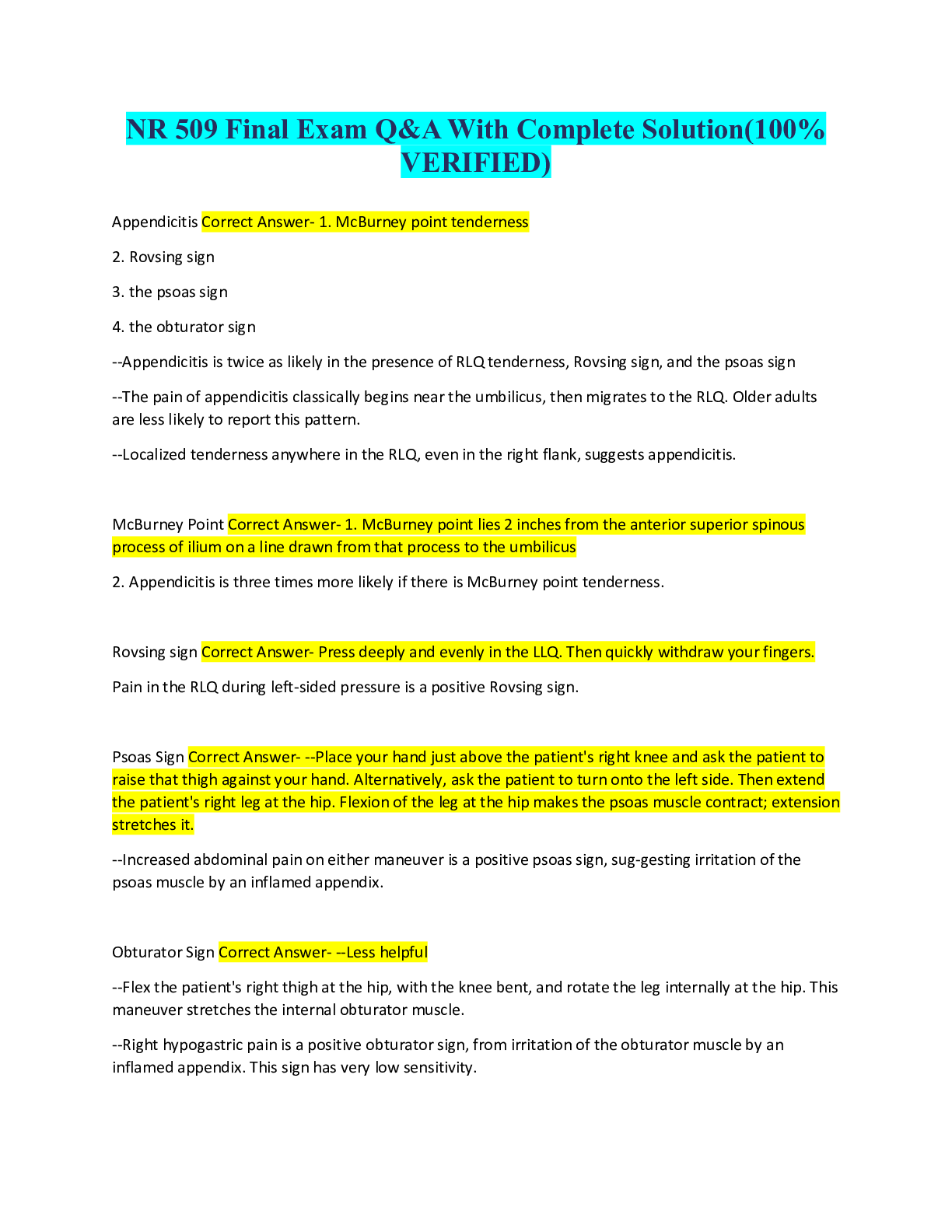
Buy this document to get the full access instantly
Instant Download Access after purchase
Add to cartInstant download
Reviews( 0 )
Document information
Connected school, study & course
About the document
Uploaded On
Sep 16, 2022
Number of pages
28
Written in
Additional information
This document has been written for:
Uploaded
Sep 16, 2022
Downloads
0
Views
73
